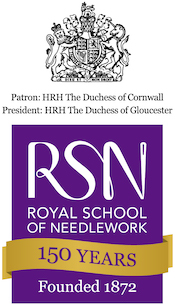Latest news
Keep up to date with all the latest news from the Royal School of Needlework
Studio News: “Never a Seat Shall Go Cold”
15th May, 2020
The RSN offers bespoke embroidery services in our Embroidery Studio, managed by Head of Studio and Teaching, Anne Butcher. In this vital role, Anne manages the Studio Team, from ensuring that quotes and finished pieces are sent to clients within a certain time frame, to guaranteeing that all work carried out by her team is to the highest technical standard.
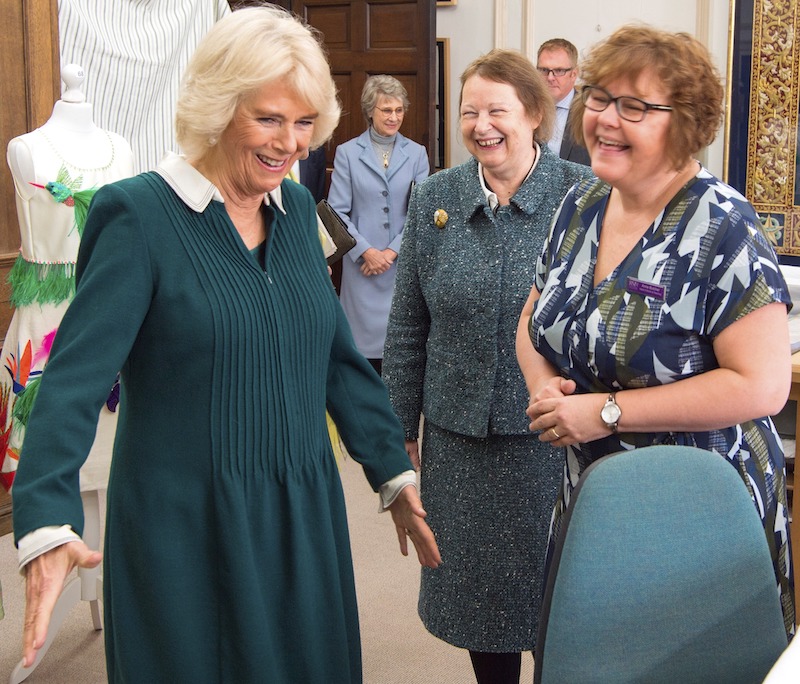
Anne with (L-R) Patron HRH The Duchess of Cornwall, President HRH The Duchess of Gloucester (in blue in the background), and RSN CE Dr. Susan Kay-Williams
Anne joined the RSN as an Apprentice in 1982 and became Assistant Head of Studio when the RSN moved to Hampton Court Palace in 1987. Two years later, Anne became Head of Studio, helping to rebuild the Studio to 20-30 embroiderers depending on the number of Apprentices in the Studio at the time. She worked with Debra Jackson and Liz Elvin to restart the Apprenticeship in the three-year format.
Anne left the Studio in 1997 to have her family, returning to teach Freelance on various courses and classes including the Apprenticeship and the Foundation Degree. 2013 saw Anne return full time to oversee the Education Department including the development of the Future Tutors Programme, taking a sideways step in 2015 to also oversee the Embroidery Studio.
The RSN Embroidery Studio has customers from all over the world, from members of the Royal Family, places of worship and livery companies to leading fashion and interior design houses and private individuals. The team creates beautiful bespoke commissions for the future as well as bring historical textiles back to life by conserving or restoring them.
Let’s start from the beginning Anne. What was your pathway to joining the RSN Apprenticeship and then to move on to becoming Head of Studio and Teaching, your position today?
When I was 13 years old, my parents gave me a Beatrix Potter Kit of Mrs Tittlemouse as a Christmas present – that was it, I was hooked, and my obsession grew from there. I disliked school, not learning, just school, so when my Mum was told about the RSN and received a copy of the Friends Newsletter containing an article by Debra Jackson about her time on the Apprenticeship, I just had to apply. Little did I know how closely I would be working with Debra in the future and that our boys would be born ten days apart!
I was invited for an interview but, as I was only 15 years old, my Mum came with me to Princes Gate, London, where the RSN was located at that time. Mrs Field, the Principle, and Miss Bartlett, Head of Workroom, interviewed me. There was only a curtain on the door to the office, so my Mum heard every word of my interview whilst she waited outside. When we left all she could say was, “I have never heard you talk so much.” I took the completed Mrs Tittlemouse as well as a selection of other samples including a three dimensional knitted burger in a bun with fabric lettuce, plate and an embroidered napkin. The day the letter came I saw the Postman put it through the door and I just knew it was from the RSN but I didn’t have time to go back home as I would have been late for school. It was a very long day and when I read that I had been offered a place it was the best feeling ever. It came before I started my exams so I knew that whatever happened I was going to be an Apprentice at the Royal School of Needlework!
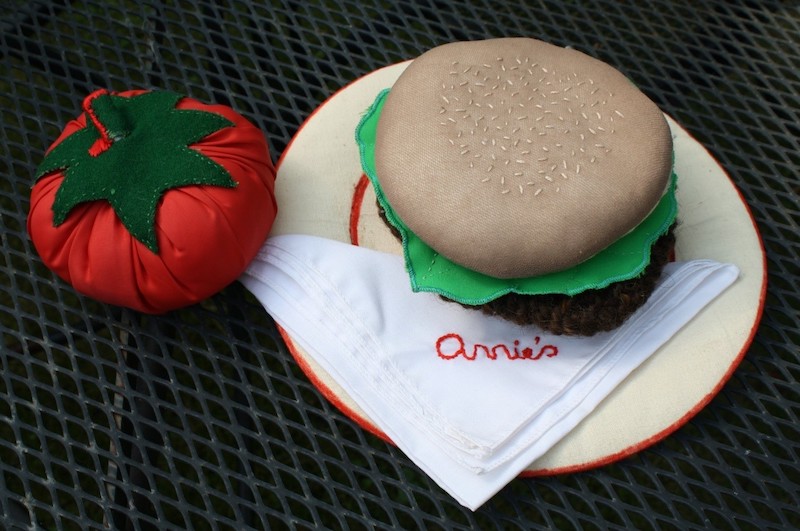
Anne’s ‘Burger’ that she brought as part of her Apprenticeship Interview
I started on 13 September 1982, aged 16, and it was the best thing in the world, I didn’t have to go to school, I was doing something that I loved, and I was working in London. I managed the 5 hour coach commute every day for a year then moved into a flat share with a couple of people from the Workroom (today the Embroidery Studio). My biggest highlight of my Apprenticeship was to have our Certificate presented by HRH The Queen Mother, what a way to finish!

HRH The Queen Mother presenting Anne with her Apprentice Certificate
I went into the Workroom at the end of my Apprenticeship working on a huge range of pieces and still learning more about conservation and restoration techniques as well as expanding my embroidery skills. We were encouraged to take up teaching which I was not overly keen on at the start, as far as I was concerned I just wanted to stitch. My first experience was to teach an ILEA class (Inner London Education Authority) with my friend; we had 20-22 students for 2 hours in the evening, each student working a different piece. It was a case of sink or swim, thankfully we swam! I went on to build my teaching experience by being sent out to teach bespoke classes, often being faced with having to prove myself in the first 10 minutes as the students expected a more mature person — sadly I don’t have that problem anymore!
How have you developed your skills and career over the years?
As I said earlier, I like to learn and I was aware there were areas within embroidery or related subjects that I had not attempted so I took day release to take City and Guild Embroidery Part 1 and 2. This was followed by an Art Foundation Course, Millinery Course, Teaching Qualification, Diploma in Machine Embroidery, finally achieving BA (Hons) in Humanities with Art History In 2017. I thought I had stopped learning for now but in the current different times I have been introduced to some very interesting free online courses.
Once the Studio moved to Hampton Court Palace, I became increasingly involved in the administrative side of the Studio, only embroidering when there was a commission with a tight deadline or extra skills in a certain technique were required if we didn’t have enough staff. The first RSN embroidery publication was produced through the Studio and, as one of the Designers, it was an exciting project to be involved in.
When I left the RSN in 1997 to start my family, I continued to teach occasionally on the Apprenticeship and on Day Classes. I also started to teach for Surrey Adult and Community Learning where I became involved in their OFSTED process by observing the Tutors which is what led me back to the RSN in a full time role in the Education department.
What has been your favourite commission?
It is difficult to pick out a particular commission that stands out. I have worked on everything from a fabric packet of KP Pistachios for a TV commercial through to a new Cloth of State for Hampton Court Palace, when the fire damaged apartment was refurbished, as well as being called in to work on a certain wedding dress… !
Tell us more about the well-known RSN Studio expression, “Never a seat shall go cold”.
We say in the Studio, “Never a seat shall go cold” which means that we are all trained to carry out work on a piece which looks like it has been carried out by the same embroiderer. In the past, an example of this would be when three of us worked and completed a cap badge in a day and it then went straight to Heathrow Airport to be flown out to the client — two bottles of champagne as an extra thank you was a nice perk!
In more recent years, one such example of this was the prestigious commission for Sarah Burton of Alexander McQueen when we worked the embroidery for The Duchess of Cambridge’s iconic wedding dress. It was such an honour to work on this most beautiful dress but, as the RSN respects our clients by signing a contract of confidentiality, then I can’t divulge too much on the work we did. I could not even tell my husband what I was working on until HRH The Duchess stepped out of her wedding car! When I see pictures of The Duchess on her wedding day, I feel such a special sense of pride in the knowledge that some of the work was done by my hands. Recently, on 11 May, Channel 5 broadcast ‘Secrets of the Royal Dressmakers’ and the RSN embroidery team was mentioned yet again!
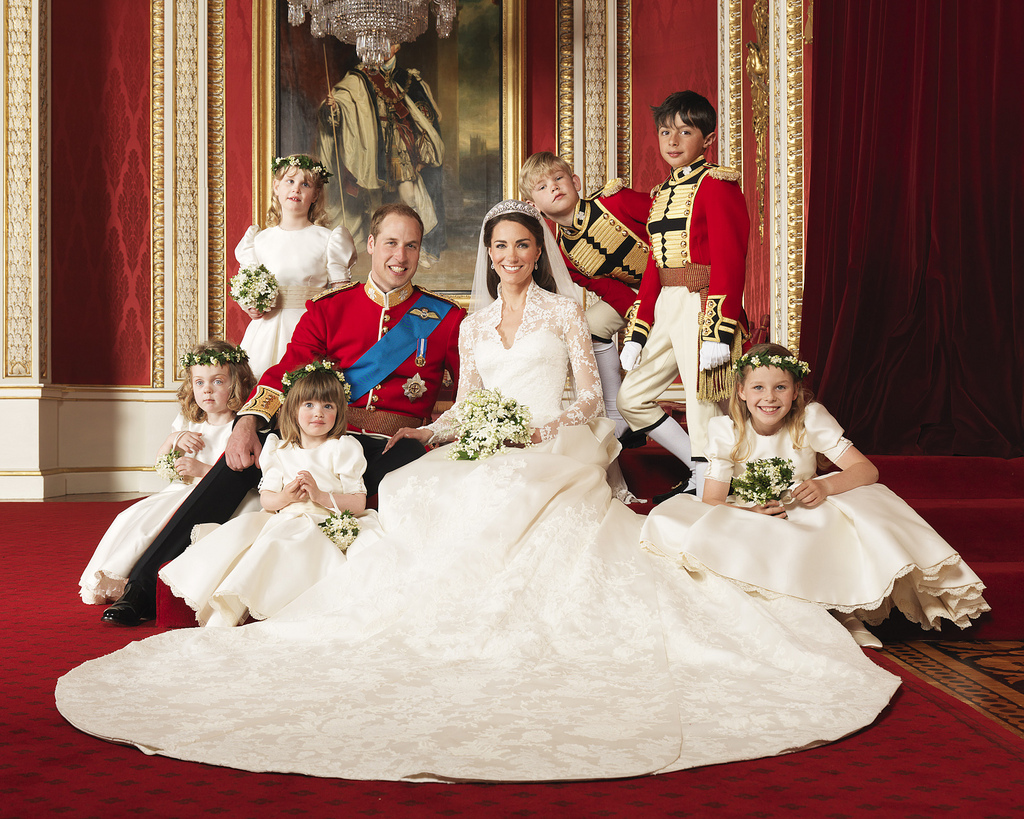
The Royal Wedding of The Duke and Duchess of Cambridge, 2011.
Picture Credit: Photograph by Hugo Burnand
What is the process when a client brings an item in to the RSN Embroidery Studio to be worked on?
Now I am back as Head of Studio the processes have developed and new techniques have been introduced, so I have had some catching up to do along with bringing back some lost techniques or variations of techniques. As our clients are from the UK and from overseas, technology has allowed us to adjust our processes accordingly.
When a client wants restoration or conservation work undertaken on a piece, they send a selection of pictures of the whole piece and the damaged areas. From these, we put together a proposal of how the piece should be treated along with approximate costs. If they wish to proceed further we request that the piece is brought or sent to the Studio for a formal estimate. There is often more than one way to treat a piece which can relate to how the piece will be used in the future. Once the formal estimate is accepted and a deposit paid we get to work. We stay in touch with the client during the process and sometimes have to revisit the estimate as we do not initially know how the piece will behave until we start working on it.
New commissions work in a similar way, with us giving approximate costs from a copy of the design. Whatever work we are undertaking we will stay in contact with the client as much as possible as it is important to keep the lines of communication open. There is always the option for the client to come and have a look while the piece is being worked.
Our clients can be a Designer, a Cathedral or Abbey, or yourself reading this interview today! Most of the pieces are significant whether as a celebration or a commemorative piece to treasure for many years to come. For example, the Studio was commissioned by Buckfast Abbey to produce a full Pontifical Set of vestments to celebrate their Millennium in 2018. It was an amazing project to be involved in and the quantity allowed for all the Embroidery Studio staff to be involved. The design involved many faces and figures with several of us revisiting Tapestry Shading.
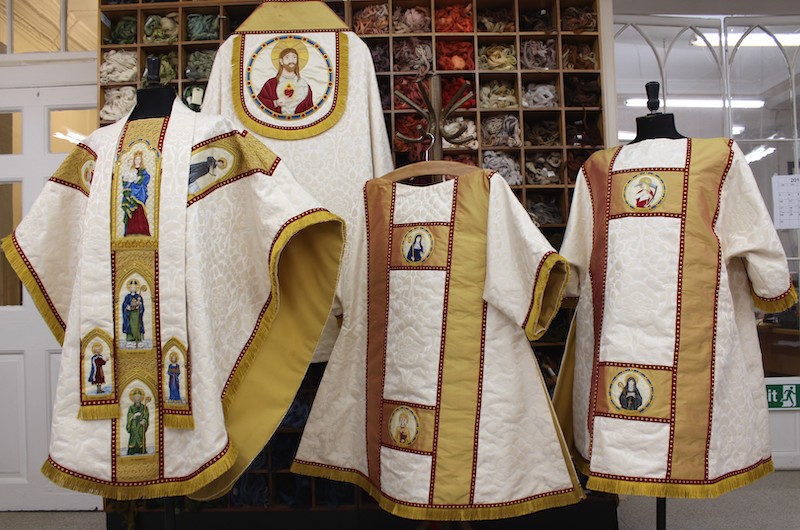
Buckfast Abbey Pontifical Set of vestments to celebrate their Millennium in 2018

RSN Embroidery Studio team working on Buckfast Abbey Pontifical Set of vestments to celebrate their Millennium in 2018
In contrast, we received a commission with an urgent deadline from Haute Couturier Malan Breton to produce two embroidered brooches/buckles for what we thought was to be a 1920s dress for a film. They were stunning, covered in Swarovski Crystals, neat and delicate. It turned out that they were for the wedding dress of American television personality Camille Grammer-Meyer in October 2018 and were seen on TV, both here and in the States, on The Real Housewives of Beverley Hills!
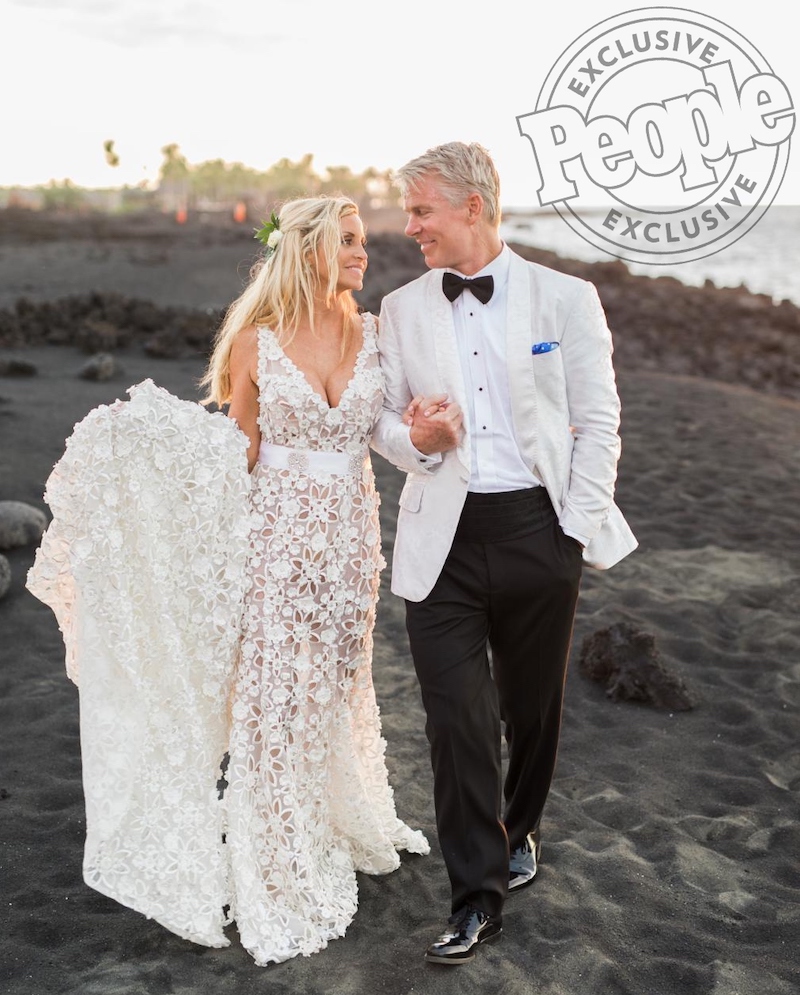
Camille Grammer-Meyer on her wedding day
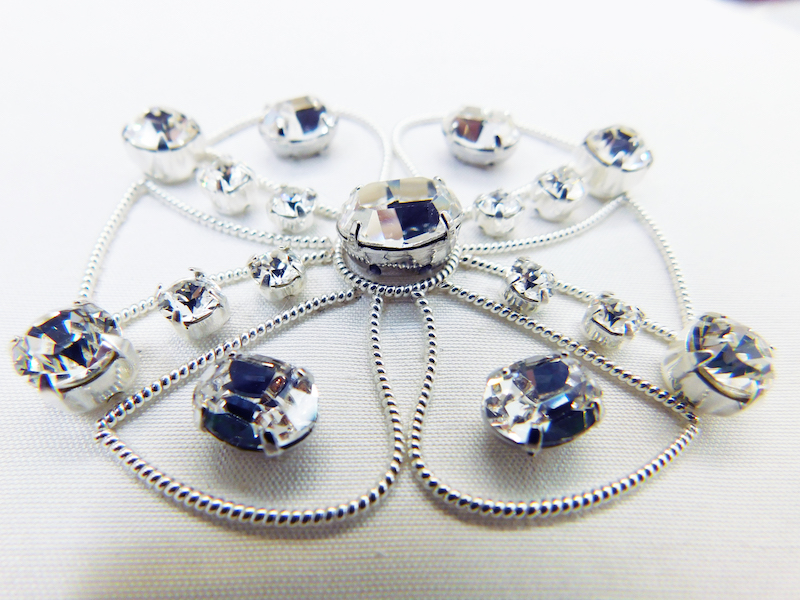
Wedding buckle for Camille Grammer-Meyer.
Recently, we have seen an increase in pieces dating back to the 16th and 17th Centuries, including book covers, caskets and church embroidery. These pieces really do give you goose bumps when you think about how they have lasted and what they have been through — we always wish that these pieces could talk! Each piece requires its own unique approach and we adapt our expert skills where necessary to suit the needs of the embroidery.
As hand embroidery is such a specialist skill to have, one would imagine that you receive quite a bit of media attention, particularly after working The Duchess of Cambridge’s wedding dress which was seen live by 2 billion people worldwide?
The RSN Embroidery Studio has, over the years, featured in the Press including Country Living magazine where I appeared as a ‘National Living Treasure’ – it took a long time to live that one down! Recently, we were in the April issue of Period Living magazine showing how we approach the repair of Victorian Berlin Wool Work, from support through to reweaving the canvas threads and replacing missing stitches and beads. Many TV crews from around the world have filmed in the RSN Embroidery Studio including from Japan and the USA.
We are sometimes contacted by production companies to give advice for the TV and big screen, to teach the actor how to hand embroider in a convincing way for their character’s role. The most recent example of this was for the 2018 film ‘Dead in a Week (Or Your Money Back)’ where the leading lady, played by actress Marion Bailey, was a prolific embroiderer. We taught her how to embroider in character as well as lending the production company a number of pieces to position on set around the house including cushions and pictures.

Actress Marion Bailey embroidering in bed in ‘Dead in a Week (Or Your Money Back)’.
Again, I can’t spill out any secrets but it’s always exciting to see how natural the actors are when the programme or film is released… a long time after teaching the actor… by which time the Studio has long ago moved on to the next projects!
What has been your highlight as Head of the RSN Embroidery Studio?
This is a difficult question to answer, every single commission is so very important to each of our customers and the RSN Embroiderers are honoured to be part of the history of each and every piece! There is no standard day which makes every day extremely exciting as I can never predict what the next phone call or email is going to bring to the team.
I am extremely proud to have been involved with the RSN for so many years. This special organisation has developed substantially over that time and, with the staff team it has now, it will continue to do so as they all believe in what the RSN represents, its mission and what it stands for, how it is part of UK heritage now and will be for many more years to come.
